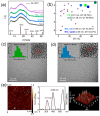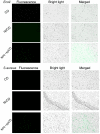Primary Amine Functionalized Carbon Dots for Dead and Alive Bacterial Imaging
- PMID: 36770398
- PMCID: PMC9920602
- DOI: 10.3390/nano13030437
Primary Amine Functionalized Carbon Dots for Dead and Alive Bacterial Imaging
Abstract
Small molecular dyes are commonly used for bacterial imaging, but they still meet a bottleneck of biological toxicity and fluorescence photobleaching. Carbon dots have shown high potential for bio-imaging due to their low cost and negligible toxicity and anti-photobleaching. However, there is still large space to enhance the quantum yield of the carbon quantum dots and to clarify their mechanisms of bacterial imaging. Using carbon dots for dyeing alive bacteria is difficult because of the thick density and complicated structure of bacterial cell walls. In this work, both dead or alive bacterial cell imaging can be achieved using the primary amine functionalized carbon dots based on their small size, excellent quantum yield and primary amine functional groups. Four types of carbon quantum dots were prepared and estimated for the bacterial imaging. It was found that the spermine as one of precursors can obviously enhance the quantum yield of carbon dots, which showed a high quantum yield of 66.46% and high fluorescence bleaching-resistance (70% can be maintained upon 3-h-irradiation). Furthermore, a mild modifying method was employed to bound ethylenediamine on the surface of the spermine-carbon dots, which is favorable for staining not only the dead bacterial cells but also the alive ones. Investigations of physical structure and chemical groups indicated the existence of primary amine groups on the surface of spermine-carbon quantum dots (which own a much higher quantum yield) which can stain alive bacterial cells visibly. The imaging mechanism was studied in detail, which provides a preliminary reference for exploring efficient and environment-friendly carbon dots for bacterial imaging.
Keywords: bacteria; carbon dots; imaging.
Conflict of interest statement
The authors declare no conflict of interest.
Figures







References
Grants and funding
LinkOut - more resources
Full Text Sources

